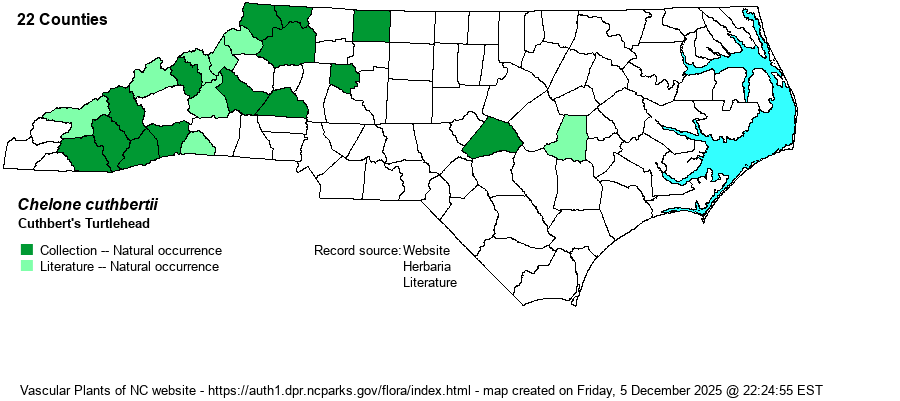| Author | Small | |
| Distribution | Primarily limited to the Mountains and western Piedmont, where it is quite local in each area province. Also disjunct eastward to central NC to Harnett and Wayne counties. A record from Davie County came from the USDA website, but there is no specimen at SERNEC; and a specimen from Forsyth County has been removed from the map as it was at a street corner in Winston-Salem, probably planted there.
This species is limited to a small area in the eastern states and is essentially restricted to VA and NC. However, in VA it is found mostly in the southeastern counties, and barely in the southwestern mountains; it continues south through NC, mainly in the mountains, and barely into northeastern GA and eastern TN. Thus, the range is strongly disjunct, like no other species. | |
| Abundance | Locally uncommon in the Mountains; rare and local in the northwestern quarter of the Piedmont, east and south to Stokes, Davie, and Catawba counties. Extremely rare eastward to the western Coastal Plain, and practically absent in the eastern two-thirds of the state. However, it does occur in two southeastern VA border counties, and thus it could be found in a few northeastern NC counties. Though it is given an S3 State Rank, it is nonetheless legally state listed as Special Concern. | |
| Habitat | Most of the Chelone species are found in similar habitats: bogs, swamp openings, wet thickets, and seeps -- generally in partly to mostly shaded situations. |
| Phenology | Blooms from late July into September; fruits from September to October. | |
| Identification | This is a rather tall herbaceous species of semi-shaded wetlands, with a single unbranched stem reaching about 2 feet tall. It has scattered pairs of opposite leaves along the stem; each leaf is essentially sessile, being lanceolate and about 3 inches long and 1-inch wide, serrated with small teeth, and strongly rounded at the base. The other three Chelone species in NC have short, though noticeable petioles on the leaves. Also, this is the only species that has its dense flower cluster -- a spike at the top of the stem -- 4-ranked as seen from above, with one flower aligned directly overtop of the ones below it. The flowers, with a characteristic "turtle head" shape, are about 1-inch long and mostly purple to rose-purple in color. The other species have rose-colored flowers, or white flowers with rose, but no others trend to a purple color. In general, do not rely on flower color, but instead use the 4-ranked flowers and the sessile leaves as the separating marks. This species and C. obliqua are scarce enough that you likely will have great trouble finding them on your own, unless you have directions to known spots. | |
| Taxonomic Comments | None
| |
| Other Common Name(s) | None | |
| State Rank | S3 | |
| Global Rank | G3 | |
| State Status | SC-V | |
| US Status | | |
| USACE-agcp | OBL link |
| USACE-emp | OBL link |

